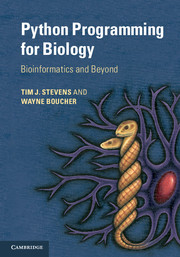Book contents
- Frontmatter
- Contents
- Preface
- Acknowledgements
- 1 Prologue
- 2 A beginners’ guide
- 3 Python basics
- 4 Program control and logic
- 5 Functions
- 6 Files
- 7 Object orientation
- 8 Object data modelling
- 9 Mathematics
- 10 Coding tips
- 11 Biological sequences
- 12 Pairwise sequence alignments
- 13 Multiple-sequence alignments
- 14 Sequence variation and evolution
- 15 Macromolecular structures
- 16 Array data
- 17 High-throughput sequence analyses
- 18 Images
- 19 Signal processing
- 20 Databases
- 21 Probability
- 22 Statistics
- 23 Clustering and discrimination
- 24 Machine learning
- 25 Hard problems
- 26 Graphical interfaces
- 27 Improving speed
- Appendices
- Glossary
- Index
- Plate section
16 - Array data
Published online by Cambridge University Press: 05 February 2015
- Frontmatter
- Contents
- Preface
- Acknowledgements
- 1 Prologue
- 2 A beginners’ guide
- 3 Python basics
- 4 Program control and logic
- 5 Functions
- 6 Files
- 7 Object orientation
- 8 Object data modelling
- 9 Mathematics
- 10 Coding tips
- 11 Biological sequences
- 12 Pairwise sequence alignments
- 13 Multiple-sequence alignments
- 14 Sequence variation and evolution
- 15 Macromolecular structures
- 16 Array data
- 17 High-throughput sequence analyses
- 18 Images
- 19 Signal processing
- 20 Databases
- 21 Probability
- 22 Statistics
- 23 Clustering and discrimination
- 24 Machine learning
- 25 Hard problems
- 26 Graphical interfaces
- 27 Improving speed
- Appendices
- Glossary
- Index
- Plate section
Summary
Multiplexed experiments
In many areas of biological and medical science, as new techniques and machinery are developed there is a tendency to record ever increasing amounts of data. A notable example of this is comes with ‘next-generation’ DNA sequencing, which we discuss further in Chapter 17. In general though, with high-throughput methods the idea is to perform many small experiments, of the same design, in parallel. When we simultaneously detect the outcome of many assays the procedure can be described as being multiplexed. This not only has speed advantages but can also reduce costs and improve consistency between experiments. And naturally, to handle large numbers of experimental assays it is important to use computers for the processing and analysis of data.
A multitude of modern techniques involve parallel experiments, including the detection of potential drug compounds, RNA molecules, antibodies and protein crystals, to name only a few. However, in this chapter we do not have space to cover the informatics of lots of specific techniques, so instead we cover general themes, such as data organisation, normalisation and comparison. Also, all of the examples will be based on the notion of the experimental data being arranged as a rectangular array, which in turn is often a consequence of the physical manner in which the assays were performed and detected, on some form of regular grid.
- Type
- Chapter
- Information
- Python Programming for BiologyBioinformatics and Beyond, pp. 316 - 340Publisher: Cambridge University PressPrint publication year: 2015



